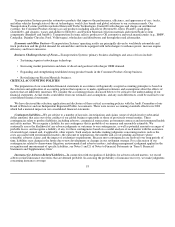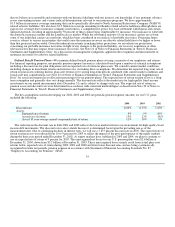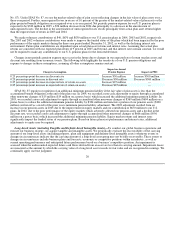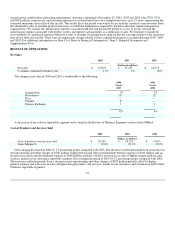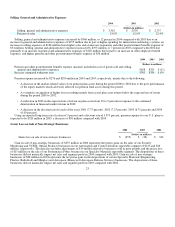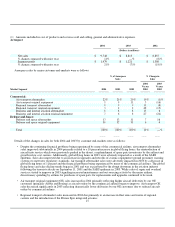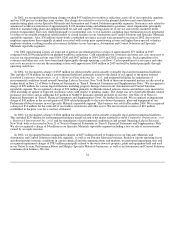Honeywell 2004 Annual Report Download - page 38
Download and view the complete annual report
Please find page 38 of the 2004 Honeywell annual report below. You can navigate through the pages in the report by either clicking on the pages listed below, or by using the keyword search tool below to find specific information within the annual report.
Interest and Other Financial Charges
2004 2003 2002
(Dollars in millions)
Interest and other financial charges $ 331 $ 335 $ 344
% change compared with prior year (1)% (3)% (15)%
Interest and other financial charges decreased by 1 percent in 2004 compared with 2003 due principally to lower average short-
term debt outstanding in the current year. Interest and other financial charges decreased by 3 percent in 2003 compared with 2002 due
principally to lower average interest rates.
Tax Expense (Benefit)
2004 2003 2002
(Dollars in millions)
Tax expense (benefit) $ 399 $ 296 $ (725)
Effective tax (benefit) rate 23.8% 18.0% (76.7)%
The effective tax (benefit) rate in 2004, 2003 and 2002 was different than the statutory rate of 35 percent due in part to tax benefits
from export sales, favorable tax audit settlements and foreign tax planning strategies. The effective tax rate in 2003 also includes tax
benefits expected to be realized as a result of the redesignation of our Friction Materials business from held for sale to held and used
resulting from the termination of discussions with Federal-Mogul Corp. The effective (benefit) rate in 2002 included the tax benefit
resulting from a higher deductible tax basis than book basis related to sales of our Advanced Circuits, PFC and Consumer Products
businesses. The impact of tax benefits from export sales, U.S. tax credits and favorable audit settlements had a more favorable impact
on our effective (benefit) rate in 2002 principally due to the relative amount of these benefits in comparison to the amount of our
pretax loss in 2002. See Note 7 of Notes to Financial Statements in “Item 8. Financial Statements and Supplementary Data” for further
information on taxes including a detailed effective tax rate reconciliation.
The American Jobs Creation Act of 2004, signed into law in October 2004, provides for a variety of changes in the tax law
including incentives to repatriate undistributed earnings of foreign subsidiaries, a phased elimination of the extra-territorial income
exclusion, and a domestic manufacturing benefit. More specifically, the Act creates a temporary incentive for U.S. corporations to
repatriate accumulated income earned outside the U.S. by providing an 85 percent dividends received deduction for certain dividends
from controlled foreign corporations. The deduction is subject to a number of limitations and currently, uncertainty remains as to how
to interpret numerous provisions in the Act. As such, we are not in a position to determine whether, and to what extent, we might
repatriate foreign earnings. Based on our analysis to date, however, it is reasonably possible that we may repatriate some amount up to
approximately $2.6 billion. We estimate the income tax effects of repatriating $2.6 billion to be approximately $150 to $350 million.
Honeywell has not provided for U.S. federal income and foreign withholding taxes on $3.9 billion of undistributed earnings from non-
U.S. operations as of December 31, 2004. Until our analysis of the Act is completed, we will continue to permanently reinvest those
earnings. We expect to finalize our assessment later in 2005.
The extra-territorial income exclusion (ETI) for foreign sales will be phased-out over two years beginning in 2005. The deduction
for income from qualified domestic production activities will be phased-in from 2005 through 2010. Similar to the ETI benefit, the
domestic manufacturing benefit has no effect on deferred tax assets and liabilities existing at the enactment date. Rather, the impact of
this deduction will be reported in the period in which the deduction is claimed on our federal income tax return. We are currently
assessing the details of the Act and the net effect of the phase-out of the ETI and the phase-in of this new deduction. We expect to
complete our analysis later in 2005. Until such time, it is not possible to determine what impact this legislation will have on our
consolidated tax accruals or effective tax rate.
25





